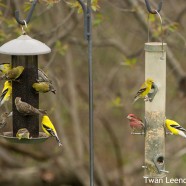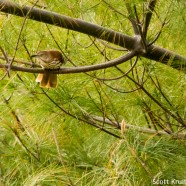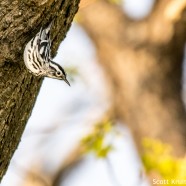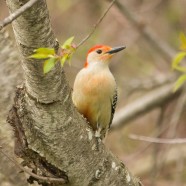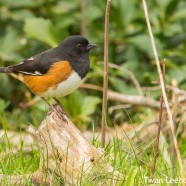Feeder Finches
There are three kinds of finches in these photos, and the views afford a great perspective of their relative sizes. The American Goldfinch, Pine Siskin and Purple Finch were all visitors to Twan’s yard recently. The Purple has such an enormous bill!
Read MoreBrown Thrasher
This Brown Thrasher (Toxostoma rufum) has been avoiding my camera for at least two weeks now. It may have a mate, but I never end up spotting any true signs of probable nesting, and certainly lack any confirmations thus far. Sadly it is a far more notable sighting than it was back in Roger Tory Peterson’s day in the Northeast. The species has dropped dramatically in abundance, and what used to be a common breeding bird for many is now a ghost in behavior and population. I am still always startled by how boldly patterned, uniquely shaped, and even loudly musical they can be, yet often...
Read MoreBlack-and-white Warbler
I couldn’t let Twan have all the fun with the Black-and-white Warblers (Mniotilta varia), and this little creeper was spotted last week as it furiously crawled and flew all around tree trunks for its insect prey. You can even see one such snack in the last photo. These birds seem like they have so much personality, but when they are visiting us in May they are move, too busy to stop to chat for too long. I am envious of anyone who gets to enjoy them while they are more relaxed on the wintering grounds. However, even then they are said to be aggressive and territorial. Did you know that...
Read MoreRed-bellied Woodpecker
In our continuing discussion of why the birds are named the way they are, here we see the reason for the name behind the Red-bellied Woodpecker (Melanerpes carolinus). Yes, they have a red head, but not as red as some woodpeckers that go by that name. These birds have pushed north over the last several decades, inhabiting new breeding grounds and in many cases year-round territories. In the last couple of weeks I have noted an influx of Red-bellied Woodpeckers, especially in migratory hot spots, showing how some definitely do move north. We can see that red belly thanks to these views...
Read MoreEastern Towhee Pair
There have been many, many Eastern Towhees (Pipilo erythrophthalmus) moving through in the last few weeks, some likely scratching away at your yard and feeders. Both the black male and brown female shown here, as recently photographed in Jamestown, New York, really do have lovely shades! Drink your tea…towhee! And Happy Mother’s Day to you and all the soon to be mothers like this one out there.
Read More



